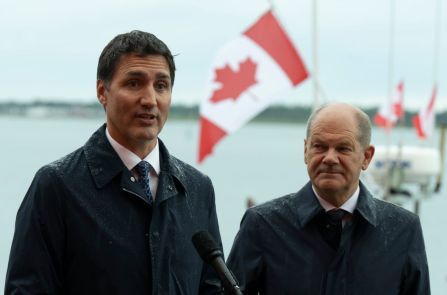
Olaf Scholz and Justin Trudeau in Stephenville, Newfoundland.
This summer, German Chancellor Olaf Scholz made his first official visit to Canada since his election last fall. The Chancellor toured the country with a contingent of the state’s largest companies and made several trade agreements relating to artificial intelligence, car manufacturing, and most prominently, Canada’s energy exports.
Together, Scholz and Canadian Prime Minister Justin Trudeau, signed the Canada-Germany Hydrogen Alliance, a "joint declaration of intent" which will encourage investment into hydrogen and establish a "transatlantic supply corridor" to export hydrogen from Canada to Germany. Exports could begin as early as 2025 from ports in Atlantic Canada with Germany emphasizing its desire for renewable hydrogen only.
Clean energy is a big priority for both the Canadian and German governments, with hydrogen being a strong contender for trade. Already one of the ten largest producers of hydrogen globally, Canada has very good conditions for the production and export of green hydrogen to Europe. The Canadian government has expressed its objective of becoming a top 3 exporter of hydrogen and has outlined its framework in its Hydrogen Strategy released in 2020.
Germany has also focused its efforts on renewable energy and diverse suppliers. In the wake of the energy crisis, the government has looked into partnerships with Australia, Chile, and the United Kingdom to gain more energy security.
The agreement, signed in Stephenville, Newfoundland, comes on the heels of an adelphi report written in 2021 on the large untapped potential for renewable energy generation in Atlantic Canada. The study focused on the favorable conditions for the production of hydrogen and its exports to Europe. As the study points out, there is a great potential for blue hydrogen production – hydrogen that has been produced with energy from fossil fuels but with carbon capture and storage mechanisms.
However, the study also found that Canada’s rich supply of renewable energy resources, like wind and solar, make it a viable exporter of green hydrogen – hydrogen produced using renewable electricity and with very low carbon intensity. Jens Honnen, one of the co-writers on the study, pointed out that the potential for renewable energy production far outweighs domestic demand in some of the Atlantic provinces, and could be used for green hydrogen exports. The report estimates Canada’s hydrogen exports could range from 25 to 35 million tonnes per year.
This potential has been understood by both governments who have been engaged in an energy partnership since March of 2021. Formal dialogue on the topic of hydrogen between government officials, NGOs, and industry partners has been accompanied by private sector engagement, with around ten projects in planning on Canada’s Atlantic coast, with the goal to supply green hydrogen in the form of ammonia to off-takers in Germany, which include major energy companies and players. For some of the projects, existing infrastructure may be leveraged to start shipping from 2025 onwards. At the same time, these projects will need to develop large-scale wind farms and the infrastructure to produce, store and ship hydrogen across the Atlantic. That being said, it is likely that we see shipping volumes of significant scale only from the 2030s onwards.
The agreement is a big step forward as interest groups have been pushing for a green hydrogen corridor for some time. However, it is worth noting the details. While Canada is interested in producing hydrogen from fossil fuels, nuclear and renewables, Germany has made clear in their Hydrogen Strategy that it only sees renewable hydrogen as the long-term sustainable solution for its energy transition. That is why all of Germany’s funding programmes are geared towards renewable hydrogen.
It is also worth noting that Canada and Germany do not share the same definition of ‘clean hydrogen’. Germany employs the color system, with ‘green’ being hydrogen produced from renewables – while Canada’s definition of ‘clean’ involving a mix of green and blue. The agreement does stipulate an intent to develop a common methodology for the carbon intensity of hydrogen which will the standardize the definitions of clean or low-carbon hydrogen. Though, this may prove a challenge given the interests of Canadian provinces with large fossil-fuel resources.
Nonetheless, Honnen argues that this agreement sends out a big signal on the importance of renewable energy trade to companies in Canada and Germany, after the political focus has largely been on fossil fuels in the context of Europe’s energy crisis. It amplifies both countries’ commitment to renewable energy trade and this may result in more players being interested in Canadian-German hydrogen cooperation now than before. While the exports may not solve the European energy crisis today, it will contribute to the long-term supply of Germany with renewable energy and encourage other countries to participate in similar agreements.

